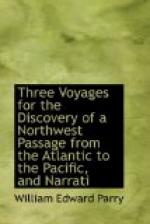We moved at six P.M. on the 4th, and soon came to a number of lakes from half a mile to two miles in length occurring in chains of three or four together, round which we had to walk, at the expense of much time and labour. At half past six, on gaining a sight of the sea from the top of a hill, we immediately recognised to the eastward the numerous islands of red granite described by Captain Lyon; and now perceived, what had before been surmised, that the south shore of Richards’s Bay formed the northern coast of the inlet, up which his journey with the Esquimaux had been pursued. Our latitude, by account from noon, being now 69 deg. 28’, we felt confident that a short walk directly to the south must bring us to any strait communicating with that inlet, and we therefore pushed on in confident expectation of being near our journey’s end. At seven P.M., leaving the men to pitch the tent in a sheltered valley, Mr. Richards and myself ascended the hill that rose beyond it, and, on reaching its summit, found ourselves overlooking a long and narrow arm of the sea communicating with the inlet before seen to the eastward, and appearing to extend several miles nearly in an east and west direction, or parallel to the table-land before described, from which it is distant three or four miles. That the creek we now overlooked was a part of the same arm of the sea which Captain Lyon had visited, the latitude, the bearings of Igloolik, which was now plainly visible, and the number and appearance of the Coxe Islands, which were too remarkable to be mistaken, all concurred in assuring us; and it only, therefore, remained for us to determine whether it would furnish a passage for the ships. Having made all the remarks which the lateness of the evening would permit, we descended to the tent at dusk, being directed by a cheerful, blazing fire of the andromeda tetragona, which, in its present dry state, served as excellent fuel for warming our provisions.
Setting forward at five A.M. on the 5th, along some pleasant valleys covered with grass and other vegetation, and the resort of numerous reindeer, we walked six or seven miles in a direction parallel to that of the creek; when, finding the latter considerably narrowed, and the numerous low points of its south shore rendering the water too shoal, to all appearance, even for the navigation of a sloop of ten tons, I determined to waste no more time in the farther examination of so insignificant a place. The farther we went to the westward, the higher the hills became; and the commanding prospect thus afforded enabled us distinctly to perceive with a glass that, though the ice had become entirely dissolved in the creek, and for half a mile below it, the whole sea to the eastward, even as far as Igloolik, was covered with one continuous and unbroken floe.
Having now completely satisfied myself, that, as respected both ice and land, there was no navigable passage for ships about this latitude, no time was lost in setting out on our return.




